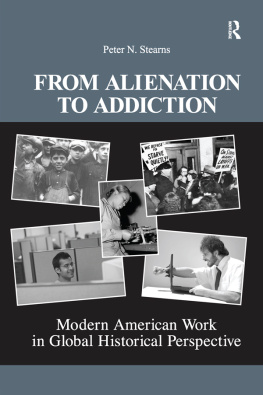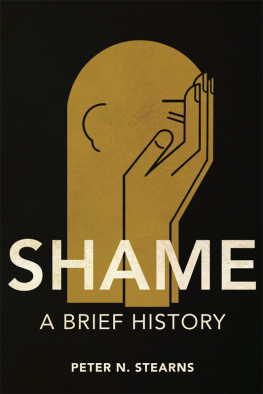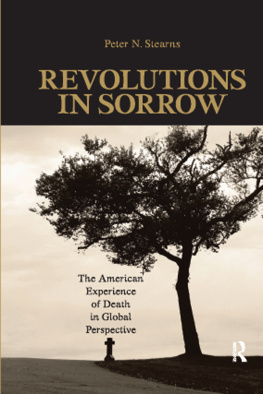Thank you for buying this ebook, published by NYU Press.
Sign up for our e-newsletters to receive information about forthcoming books, special discounts, and more!
Sign Up!
About NYU Press
A publisher of original scholarship since its founding in 1916, New York University Press Produces more than 100 new books each year, with a backlist of 3,000 titles in print. Working across the humanities and social sciences, NYU Press has award-winning lists in sociology, law, cultural and American studies, religion, American history, anthropology, politics, criminology, media and communication, literary studies, and psychology.
American Behavioral History
American Behavioral History
An Introduction
EDITED BY
Peter N. Stearns
NEW YORK UNIVERSITY PRESS
New York and London
www.nyupress.org
2005 by New York University
All rights reserved
Library of Congress Cataloging-in-Publication Data
American behavioral history : an introduction /
edited by Peter N. Stearns.
p. cm.
Includes bibliographical references and index.
ISBN13: 9780814798430 (cloth : alk. paper)
ISBN10: 0814798438 (cloth : alk. paper)
ISBN13: 9780814798447 (pbk. : alk. paper)
ISBN10: 0814798446 (pbk. : alk. paper)
1. PsychologyUnited StatesHistory. 2. United States
Social conditions. 3. United StatesSocial life and customs.
I. Stearns, Peter N.
HN57.A5847 2005
306.0973dc22 2005012783
New York University Press books are printed on acid-free paper, and their binding materials are chosen for strength and durability.
Manufactured in the United States of America
c 10 9 8 7 6 5 4 3 2 1
p 10 9 8 7 6 5 4 3 2 1
To the memory of Linda W. Rosenzweig, 19422005, colleague and friend, an imaginative historian and educator
Contents
Peter N. Stearns
Gary Cross
Paula S. Fass
Linda W. Rosenzweig
Susan J. Matt
Steven M. Gelber
Peter N. Stearns
Suzanne Smith
Mark M. Smith
Kevin White
Preface
This is a book about a new way of using history, to understand basic aspects of human and social behaviorin this case, in the United States, but potentially more widely. Of course, like most novel endeavors, it is not fully new. We all use history to explain phenomena such as current voting patterns (which often seem surprisingly, even troublingly, rooted in the past). We readily see certain current institutions emerging from a combination of change and continuity from the past. But we have typically subjected only a fraction of relevant behaviors to historical scrutiny, and for their part some of the most imaginative historians, when opening new topics in the past, have been a bit timid about bringing them forward to explicate the present.
The book thus springs from recognition of the utility of the explosion of historical knowledge over the past forty years, though it focuses on deliberately grasping the present as emerging from the past. The book does not invite all historians to do behavioral history and does not claim that history alone explains key behaviors. But there is a missed opportunity in the current gap between historical innovations and the range of vantage points available on distinctive features of contemporary values and actions. Behavioral history requires quite explicit analysis from historians, beyond some of the conventional presentations in the discipline, and this can be truly exciting. It requires new openness from scholars in other disciplinesand happily, there are many signs of this trend already, in fields such as alcohol or obesity studies. It deserves new attention from interested users of history, alongside the more familiar entertainment fare of battles and biographies. There is nothing wrong with the latter, but there are opportunities for historical exploration of dominant assumptions and practices that are simply too important to be neglected.
Behavioral history coins a new approach, but it depends on the work of countless scholars in social and cultural history over the past generation and more, and it invites a new commitment, from history training programs on up, to widen historys utility just as its field of inquiry has expanded.
1
Introduction
Peter N. Stearns
Over the past thirty years, many Americans have developed not only a healthy fear of tobacco smoke, but an eager disapproval of smokers. Only slightly deflected by criticisms of the ploys of Big Tobacco or possible genetic proclivities on the part of smokers, Americans have turned against smokers not only as threats to health but as creatures of bad character. As one expert put it in 1991, smoking constitutes some element of human frailty or incompleteness in the smoker deserving of every reproof both because smokers were nothing more than merchants of death and because cessation was simply a matter of self-discipline, readily mastered with learning and practice.1 Harsh beliefs translate into rigorous laws and also into the shamed ghettoization of smokers as they cower in building entrances, weathering the glares of self-righteous passers-by. The whole phenomenon is a not inconsiderable passage in recent American history, as both behaviors and attitudes reversed trends of the mid-20th-century decades. But it is not recent history alone. The unusual fierceness and moralism of the American responsequite different from reactions in other industrial countries, despite the same health dataderive from an association of health and good character that took shape in the 19th and early 20th centuries, and with an American delight in castigating sinnersalbeit, now, secular sinnersthat blended Puritanism with Victorian values even earlier. Our antismoking stance, though partly derived from rational health campaigns that gradually won through, can only fully be understood through a richer history.
This, in turn, is behavioral history in a nutshell: the capacity to understand ourselves, including depths of feeling and differences from other societies and subgroups, through the use of historical explanation. There is no way to grasp why many Americans react to smokers as they do without looking at some deep features of our history, not only the health campaigns that led up to the reversals of policy in the 1970s, but also the older moralism and its transitions from sin to issues of health and character.
Behavioral history rests on two assumptions. The first involves the conviction that substantial components of beliefs and actions, even in very personal areas, are shaped by developments in the past. They cannot be fully understood without examining their origins and the factors that shaped and sustained them. The second assumption embraces the wide range of behaviors that historians are now capable of probing, well beyond conventional textbook staples of wars and presidents, and even beyond the newer trinity of class, race, and gender. While gaps remain, including some that probably can never be filled for lack of adequate data, an explosion of historical knowledge has occurred in the past quarter-century that greatly improves our capacity to understand ourselves. Behavioral history, as a label, seeks to use this capacity for exactly that purpose, building on but surpassing the historians delight in adding to the richness of the past.












